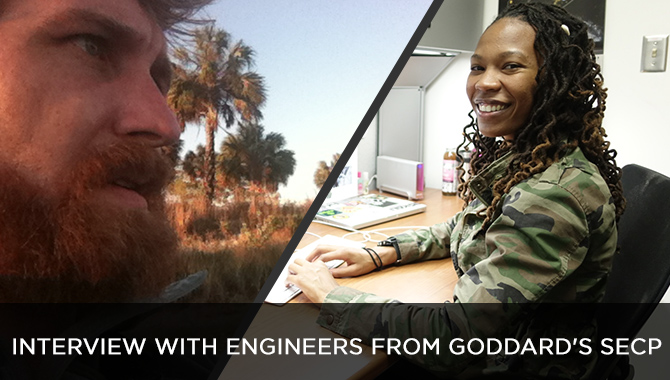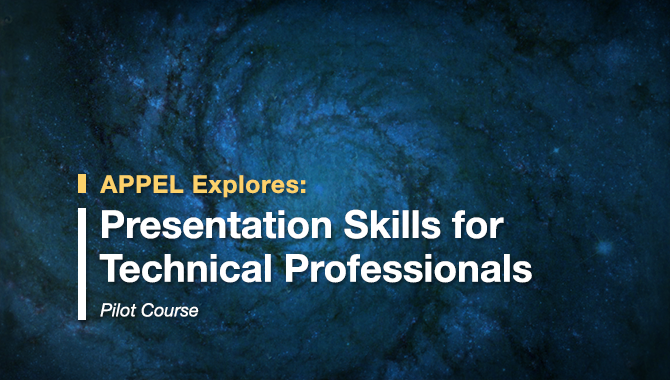
Members of GSFC's Science & Engineering Collaboration Program (SECP)--electronics engineer Jack Sadleir (left) and aerospace engineer Sabrina Thompson (right)--along with SECP program manager Rebecca Derro (not pictured) discussed the benefits of APPEL's course Presentation Skills for Technical Professionals.
Photo Credits: Jack Sadleir (left)/Natasha Johnson (right)
Can good presentation skills help advance science and technology? Goddard Space Flight Center’s (GSFC) Science & Engineering Collaboration Program (SECP) decided to find out.
For most engineers and scientists, the important work takes place in the lab or in the field—not in a conference room. But what happens when a project requires funding for further development? How can technical professionals convey the importance and potential benefits of their projects to a wide range of audiences who might not easily grasp the subject matter or its value?
Goddard’s SECP, which serves as a training ground for future lead engineers and principal investigators, decided to tackle this issue head on. In addition to their regular program, which helps integrate the science and engineering needs and research interests of the center by bringing practitioners together to collaborate on a project for a year, SECP recommended the APPEL course Presentation Skills for Technical Professionals. For the first time, SECP participants not only focused on advancing collaborative technical work, they learned how to communicate their ideas in order to advance the potential of their projects outside of the lab. APPEL News sat down with SECP program manager Rebecca Derro and participants Jack Sadleir, PhD, Electronics Engineer, and Sabrina Thompson, Aerospace Engineer, to learn more about their experience in the APPEL course and how they believe the skills they learned will support their professional goals.
APPEL News: Let’s start with the basics. Can you tell us a bit about SECP?
Rebecca Derro: SECP is a program in which an engineer is detailed with a scientist for a period of one year to work on a project. It’s a hands-on opportunity, so the engineer gets to actually spend time in the lab working on developing technology or on a balloon, aircraft, or cubesat experiment. The idea behind the program is to bridge the gap between engineering and science, helping each practitioner learn about the other’s culture. For example, the scientist learns about the resources that engineering can provide to their work. And for the engineer, they learn about the science their work is supporting.
Sabrina Thompson: Through being in the program, I’ve been exposed to the wonderful world of science, if you will. A lot of the work we do as engineers is driven by the science, so it’s important to know how scientists think, how they work, and what’s important for them as far as their research topics and mission goals.
Jack Sadleir: One part of what SECP did for me was help expand how I think about my work. For instance, this past year I got to be on a red team proposal review. That’s an internal Goddard process: before a proposal is submitted to NASA HQ [Headquarters], they have experts review the proposal and give feedback to try to improve it. I was asked, as a detectors expert, to read a proposal for a low-temperature detector. From the science side, senior astrophysicist John Mather was selected to review the detector, too. I bring this up because John said something that, to me, put detector work in important perspective. I don’t have the quote exactly, but he shared that the entire spacecraft, weighing many thousands of kilograms, is generally determined by the detector, which is a small chip that typically weighs less than a gram. That’s part of what SECP gave me an opportunity to see. It showed me how the small thing I work on fits into the broader scheme of a mission. It expanded my focus from what it was in the past—coming up with new types of ultra-sensitive detector technologies and how to improve upon them—to something much bigger.
APPEL News: What kind of projects do participants work on in SECP?
Sadleir: I collaborated with Harvey Moseley, a senior astrophysicist and detector expert here at Goddard. He and I worked on finding a solution for two NASA missions in particular: LUVOIR [Large UV/Optical/Infrared Surveyor] and HabEx [Habitable Exoplanet Imaging Mission]. They are part of the astrophysics 2020 Decadal Survey, which guides NASA’s mission priorities for the next decade. Both missions are designed to look for life on exoplanets. To do that, they need a detector that can measure the energy of the photons that have, in effect, reflected off of an exoplanet. It’s a very faint source of light, a very slow stream of collecting photons. You build up a histogram of the energy of those photons and then do spectroscopy to look for biosignatures. For instance, one of the gold standard biosignatures is the presence of both methane and oxygen in the atmosphere of an exoplanet. That is a very strong indicator of life.
Harvey and I worked on developing a detector that would satisfy requirements for both the LUVOIR and HabEx instruments. I should point out that for both instruments, NASA HQ has already funded low-temperature detectors. But they haven’t investigated the use of superconducting transition-edge sensors (TESs), which are a type of low-temperature detector that operates based on principles of thermodynamics. TESs already hold the energy resolution record, but Harvey and I want to push them further and to achieve higher energy-resolution powers in the optical band. We came up with two different strategies to accomplish these goals. First, we want to design TESs to operate in the non-linear regime. Second, we want to use magnetic fields to change the resistive transition surface of a superconductor. Both of these could advance the state of the art for TESs.
APPEL News: It seems like a far cry from coming up with new strategies to advance TESs to taking a course about improving presentation skills. Why did SECP management decide to include Presentation Skills for Technical Professionals in the program?
Derro: We regularly recommend courses to the SECP participants depending on their background. Presentation Skills for Technical Professionals appealed to us because we’re all about communication here. And the way we communicate, more and more, is through presentations. We find presentations are an effective way to share information with audiences who have different backgrounds. You talk to engineers, scientists, senior managers, resource analysts, planners—and you have to be able to communicate to all those different stakeholders so that your work is understood and effective decisions can be made. We find that engineers have some experience doing presentations, but normally it’s an area where a lot of people struggle. I think Presentation Skills for Technical Professionals gives them a great foundation for how to put together a really good presentation that’s clear, easy to understand, and gets across the message that needs to be communicated.
APPEL News: Sabrina, as an SECP participants, how did the course benefit you?
Thompson: I struggle with putting presentations together. From the Presentation Skills for Technical Professionals course, I learned about the idea of telling the story. Essentially, how to tell the story you are trying to communicate and own it without putting too much on a slide—really trying to use more pictures than words. This allows your audience to listen to you without trying to read the text on the slides at the same time.
When I delivered my final presentation, I found using more images and less text made it easier for the audience to follow—as well as easier for me to tell the story. For instance, many of the elements I had to include on my slides involved processes. So, on the slide, I displayed a flow chart depicting the process, then I told the audience about it verbally. They could see the process and learn about it from what I was saying.
One thing I learned is the more pictures you have that show what you’re actually trying to describe, the better you can tell the story—and the more likely it is that audience members will be able to follow your presentation. This is so important, especially for a technical presentation, which can be very difficult to follow all the way through. People can get lost in certain areas and then it is hard for them to pick up from there. The techniques we learned in the course made it easier for everyone to follow the presentation and really understand the message.
APPEL News: So you found it effective to use your slides to communicate visually and then provide the story verbally. What other techniques were helpful?
Thompson: That was the main component I found I could include in my presentations right away. There were others aspects of the course that I’m still working on, such as body language. Communication is less than 10 percent verbal and roughly 90 percent non-verbal. The class taught us techniques for using body language that I would definitely like to include in future presentations.
APPEL News: Jack, what did you find valuable or useful in the course?
Sadleir: Originally, I expected it to be quite different than it actually was. I expected it to be more about how to present graphs and make sure you can read your axis labels, things like that. But the course didn’t touch on that at all—it didn’t try to. It was about something very different. The course focused on how to engage people during a presentation. Using your voice and tone and inflection to keep people interested as well as your body language. And telling a story about your idea: creating a narrative that helps people really understand your presentation. Overall, it showed us a way of being more effective in communicating our ideas. I liked that. It made me consider things I hadn’t before.
APPEL News: What kinds of things did you find yourself considering as a result of the course?
Sadleir: One thing I was surprised by was that “upspeak”—where you end a sentence by inflecting your voice upward, like asking a question—is not well received. Also, in terms of body language, they discussed in class that some of my resting postures might be a little bit distracting to an audience. Again, these are things I would never have considered.
Another thing was that, at some level, packaging matters. I like the sciences because I find the work more about content than packaging. But I realize that, in terms of communicating with others, the right packaging could make the difference between having your idea considered or not. There are lots of people with good ideas who have concepts they want to see developed further. I think Harvey and I, for example, have come up with two good strategies for advancing TESs. But I learned having a great idea is not enough; you need to have the right people hear it and also understand it. That’s where I’m at with my project. I need to get development money to try these ideas out. I can see how some of the lessons learned from Presentation Skills for Technical Professionals could help me do that. The techniques were not just about being slick and entertaining. Instead, they could make the difference between whether your idea is heard and understood, or not—and, therefore, whether it’s considered for funding.
APPEL News: Was there anything else you took away from the course that you found valuable?
Thompson: I deliver presentations with more confidence now. I’m definitely not as nervous as I used to be because I implement techniques I learned from the class. Moving ahead, I look forward to reaching the next level where I’m even more comfortable giving presentations.
APPEL News: Rebecca, were your expectations met in terms of how the course supported SECP participants?
Derro: From my perspective as a program manager, I think it did meet the expectations of improving the informative nature of the presentations and simplifying the slides. The challenge with a lot of us is here at Goddard is that when we put a slide together, we want to pack all the information we can on that slide. First of all, so we don’t forget what we’re going to say; and second, so it’s there for people to see. One of the things the participants learned in the course is that method doesn’t work to get your message across because people tend to read the slides when you’re talking and they miss your main point. And if the main point isn’t right there, front and center, people can get distracted by the other information on the slide. Based on the presentations we’ve seen in previous SECP classes, this year’s presentations have looked different and, I think, have been better than what we’ve seen in the past.
Keep in mind, SECP isn’t really a training program—it’s more of an opportunity, a development program. It’s not meant to be classroom-heavy at all. We don’t want to take away from the time that the engineers and scientists have together because that year goes really quickly. So we don’t recommend many courses, but we do think Presentation Skills for Technical Professionals offers something very important.
APPEL News: Sabrina and Jack, what will you be doing now that SECP is winding down?
Thompson: As a result of my experience in SECP, my network in the science community has grown. In addition, I acquired funding to collaborate with a team of scientists on a research proposal. I’ve also started pursuing a PhD in Atmospheric Physics. Most of the scientists I worked with during SECP have a background in Atmospheric p=Physics, so that will be a good fit with the work we do at Goddard. Adding to that, presentation skills are definitely going to come in handy when I have to defend my work as a PhD student.
I learned a great deal about the inner workings of my home branch through SECP. I noticed that in my branch alone, there will be a number of people retiring within the next year or two. That creates more space for the next generation—people like myself—to start making names for ourselves. But to do that, we have to acquire the knowledge possessed by those people who are on the verge of retirement. To help ensure there isn’t a knowledge gap in our branch, I proposed a knowledge sharing campaign to my supervisor that will allow us to capture the knowledge of the senior flight dynamists who are on their way out the door, so that we are not forced to reinvent the wheel upon their departure. This is where I think it will be very, very helpful to use the skills from the course in trying to encourage my branch to provide the resources necessary to pursue this endeavor.
Sadleir: Harvey and I are going to present our plan and strategy for advancing TESs to NASA HQ with the goal of obtaining funding for a development program to understand these ideas—to make the devices and see how they work. Even in a proposal, I’ll use some of the techniques from the course. After all, a proposal is a type of presentation. The course made me think of ways to present technical information in other formats, too, so that we can help people who are experts in detectors as well as technical people who do not have that particular expertise see the merit in our strategy.
APPEL News: Thanks for taking the time to talk about SECP and the Presentation Skills for Technical Professionals course. Is there anything you’d like to add?
Thompson: I think the course—and presentations in general—is an area where art and STEM [Science, Technology, Engineering, and Mathematics] can converge in a very beneficial way. I’m an artist as well as an engineer, so I’m always looking for ways to bring creativity to the workplace. When I took the course and saw how the instructors were encouraging us to use pictures and videos to tell a story in order to convey our message, I loved it. It showed me many ways to be creative using presentations.
Derro: As a program manager, I have the best interests of the participants at heart, so I want to make sure that we’re recommending something that they find useful. In this case, I think that’s what happened. It was worth it to them to take the course. They were able to apply the things they learned almost immediately because we have monthly presentations throughout the program where the participants are sharing their status and any issues they might be confronting in their detail. This is the first time we’ve recommended this course, and my initial reaction is we’re going to continue to recommend that they take it in future SECP classes.
Learn more about Presentation Skills for Technical Professionals.









